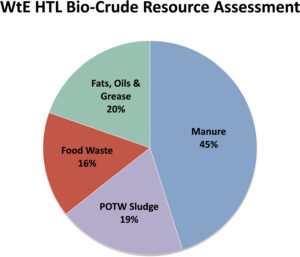Researchers from the US Department of Energy (DOE) National Renewable Energy Laboratory (NREL) and Pacific Northwest National Laboratory (PNNL) have released a report on the potential production of bio-crude from organic wastes such as wastewater sludge, animal manure, food waste, and fats, oils and greases throughout the USA.
HTL (hydrothermal liquefaction) is one technology that the researchers have been looking into. HTL is a thermochemical conversion of wet biomass into liquid fuels in a hot, pressurized liquid water environment, where water serves as both solvent and reactant. Under processing conditions of approximately 350 °C and 200 atm, and a biomass feedstock in the desirable range of 20 wt% dry solids, a reaction medium is created such that within minutes, biopolymers are deconstructed and reformed into lower molecular weight biocrude oil components. The energy-dense biocrude oil can then be upgraded to a variety of liquid hydrocarbon fuels by hydrotreating.
According to the report, HTL has a number of advantages over other thermochemical conversion methods. High lipid concentrations are not required for effective HTL energy conversion and the need for energy-intensive feedstock drying is potentially reduced or eliminated because a feedstock slurry is used as an input. The high-efficiency chemistry of HTL transforms almost all of the biomass into biocrude oil, which largely self-separates from water as the reaction solution returns to standard conditions. In addition, biomass that is not converted through the process can optionally be returned to the input feedstock slurry, thereby increasing biomass to biocrude oil conversion rates. Further, HTL does not generate significant amounts of sludge or hazardous products of combustion such as NOx.
Results indicate that for the conterminous United States, on average, as much as 5.9 billion gallons of biocrude oil could be produced each year.
The team discovered that the potential for biocrude oil generated by sludge sourced from publicly owned treatment works is 1.1 billion gallons per year. This resource was found to be widely distributed throughout the country—with a high density of sites in the eastern half of the United States and larger individual sites located in the biggest cities.
Animal manure showed the potential for 2.7 billion gallons of biocrude per year. The team found the Midwest and Great Lakes region to have the highest resource availability, with a large quantity of smaller individual sites throughout Ohio, Indiana, Illinois, Iowa, and Missouri, and several large concentrated animal feeding operations in Michigan, Wisconsin, South Dakota, Nebraska, Kansas, Oklahoma, and Texas. Concentrations of this resource are significant also in California, Washington, Idaho, Utah, and southern Arizona, with resource availability shown as well in North Carolina, Pennsylvania, and New York.
Food waste—much like wastewater sludge—was found to follow population patterns. High-density populations such as Los Angeles, Seattle, Las Vegas, New York, Phoenix and others showed high resource availability and thus high potential for biocrude oil production. This waste is estimated to produce .9 billion gallons per year—but it also had the lowest conversion rate out of the assessed feedstocks.
Fats, oils, and grease were also found to be well distributed throughout the nation, with higher density in the eastern half of the United States. With a high HTL conversion rate, the research team estimated this waste can provide 1.16 billion gallons of biocrude oil per year.





